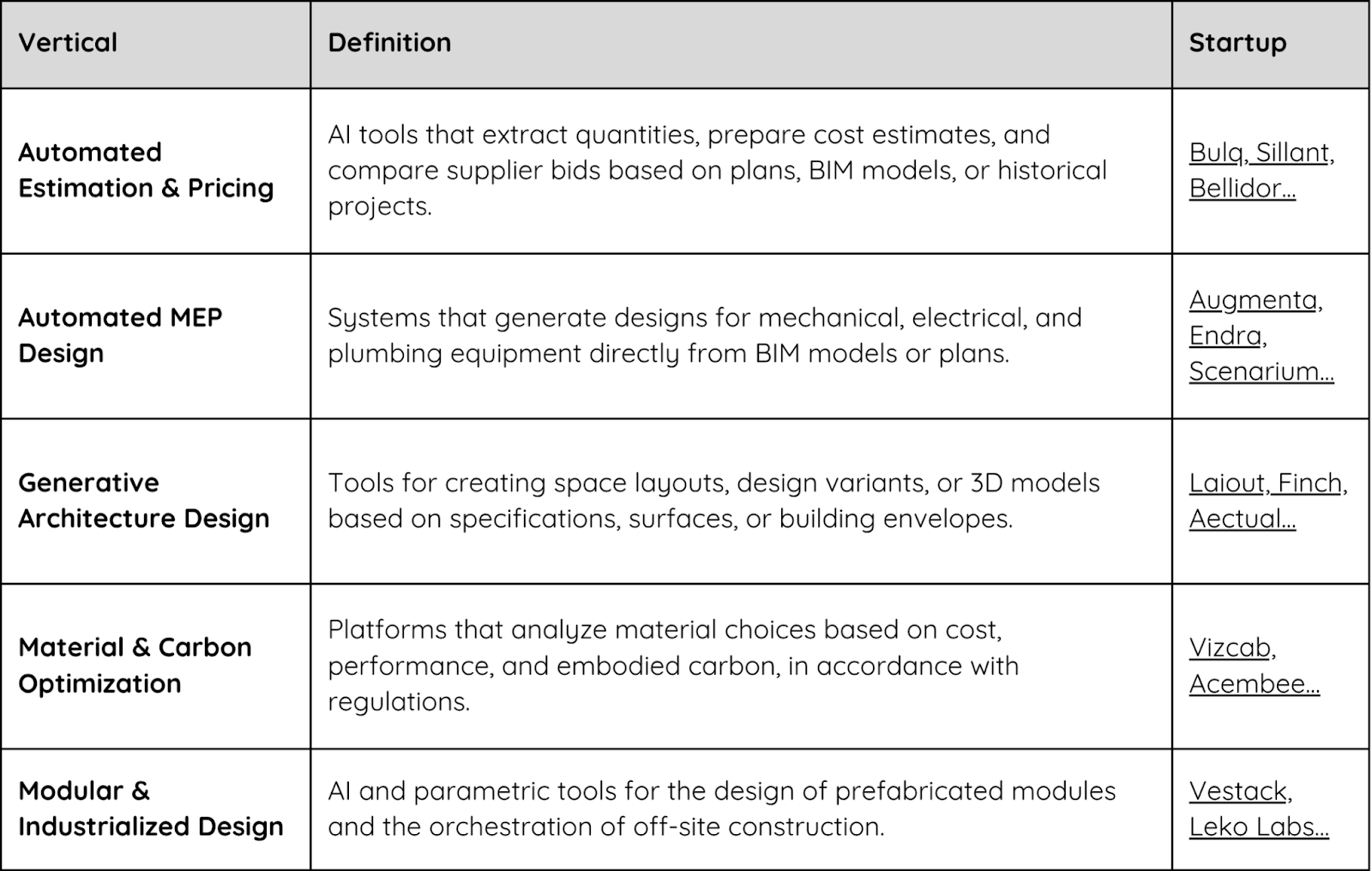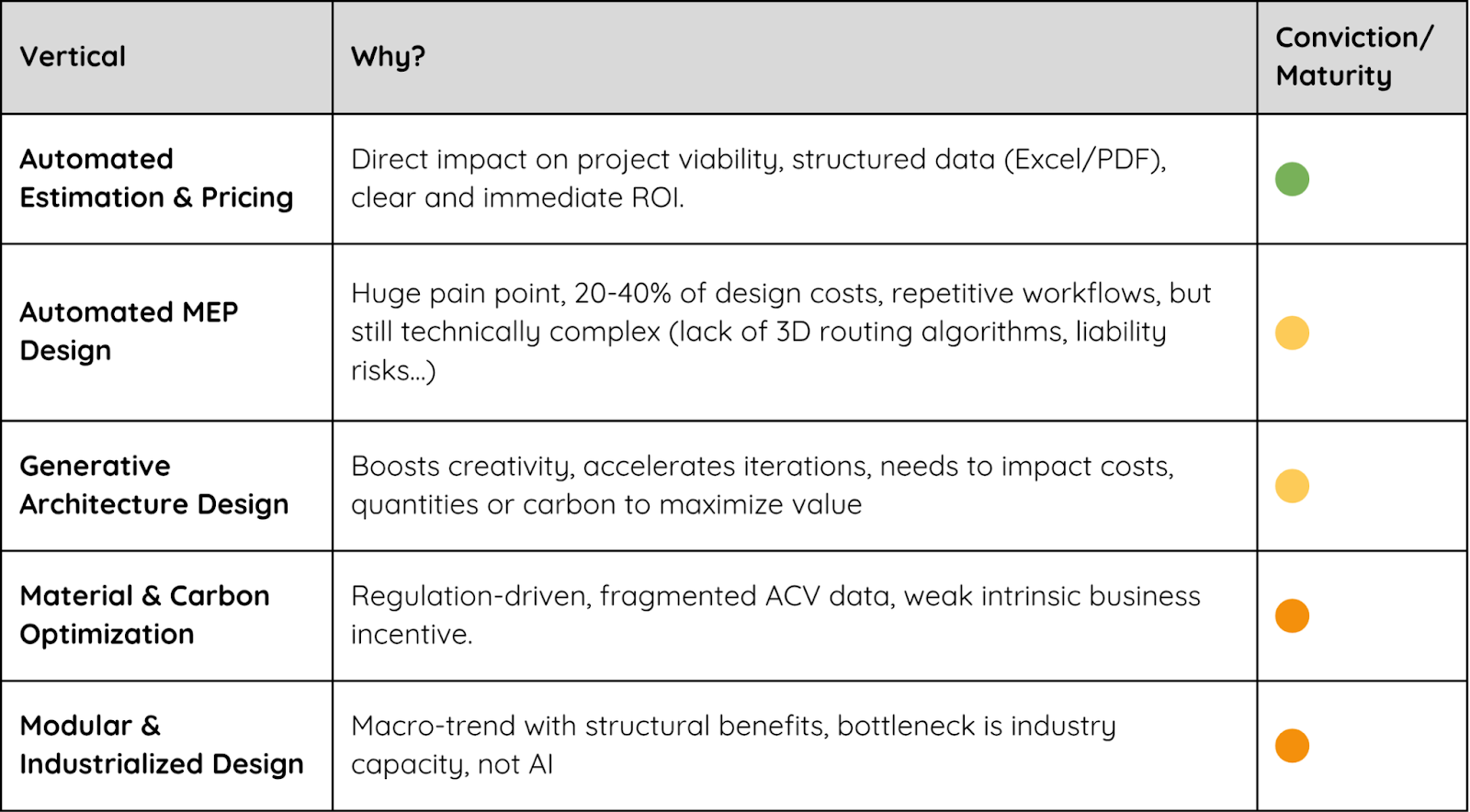Construction & AI (part. 1)
The construction sector has long been known for its low productivity growth compared to sectors such as manufacturing or aerospace. The reason for this is that every building is essentially a prototype. No two projects are alike, each involves unique constraints, materials, and stakeholders. This makes the initial building design phase both critical and costly, with a direct impact on up to 80% of future construction costs and on a given building's carbon footprint (ScienceDirect).
Rising costs, stricter carbon targets, and structural labor shortages are now pushing construction companies to innovate quickly. New generative AI technologies are undoubtedly part of the solution, but it is essential to understand for which use cases and at what level of the value chain they can deliver tangible value.
Where does AI create value in construction design today?
From what we’ve learned, most of the tools and formats used by architects, engineers, and contractors remain highly fragmented: BIM models (when they exist), endless Excel spreadsheets, scanned PDFs, and even binders containing hundreds of pages for public tenders. As one ConTech founder reminded us, this persistent “hyper-fragmentation of BIM formats” is one of the root causes of conflicts, delays, and cost overruns across the industry today. In this context, AI is emerging as a potential game-changer for the construction industry. The AI market in construction is expected to grow from $3B in 2024 to over $17B by 2030 (Grand View Research), while generative AI in construction alone is expected to grow from $140M in 2023 to nearly $2.9B by 2033 (Market.us).
To develop our investment thesis on these topics, we wanted to gain a better understanding of where AI is creating most value in construction today. We worked on this question by identifying 70+ start-ups across Europe and North America, analyzing data requirements for the use of AI in construction design, and interviewing founders and engineers currently working on this opportunity.
5 use cases for AI in early-stage construction design
Most of a building's costs and carbon impact are determined during the initial design and planning phase. But this early design phase remains dominated by manual and iterative exchanges between architects, engineers, and contractors. This provides fertile ground for AI: the tasks are repetitive, the rules are codifiable, and the data is abundant.
In this space, five verticals stand out as being the most relevant for AI applications :


The data bottleneck in Construction AI
AI’s potential in construction is clear, but its performance is only as good as the data it consumes. And this is precisely where the main bottleneck lies.
Unlike other sectors where data sets are already standardized, the construction industry still suffers from extreme fragmentation of formats. On a single project, structured BIM models may coexist with 2D CAD drawings, Excel spreadsheets, or even PDF files. This heterogeneity forces AI startups to devote almost as much effort to cleaning input data as to producing results. During our interviews, we realized that one of the main challenges, beyond algorithms, lies in data preparation and structuring. Our portfolio company Laiout, for example, has developed a tool dedicated to cleaning CAD files in order to make architects' plans directly usable by its AI model. This cleaning functionality has proven to be a real business opportunity in its own right. Some of the industry players we talked to go even further, describing most initial building design data as fundamentally unreliable, emphasizing that AI cannot create value if the input material itself is flawed.
Even when BIM models are available, they rarely follow a common standard. Attributes and labels vary by country, company, and even project. An engineer at Vinci Energies explained that two BIM models created in Revit by different clients can require hours of manual adjustments before they can be used consistently in other tools, or as input data for an AI model. This lack of standardization makes scalability more difficult for AI startups in the construction industry: what works in one country or with one customer often fails when applied elsewhere. Some experts pointed out that solving this structural problem is even more difficult than creating new algorithms. Without clearer and more consistent input data, AI remains limited to narrow, well-defined tasks.
The result is a two-speed adoption curve. Use cases such as automated estimation and pricing are already progressing rapidly, as they can work with relatively standard and accessible data (Excel spreadsheets, PDF invoices, etc.) while offering a clear ROI thanks to time savings and improved margins. On the other hand, more data-intensive areas, such as carbon optimization or modular design, are showing slower adoption, awaiting cleaner, richer, and more standardized datasets.
Ultimately, the success of AI in construction will depend less on the quality of the algorithms than on the industry's ability to standardize, clean, and share its data. Until then, start-ups that manage to build proprietary data sets or connect directly to their customers' abundant archives will benefit from a decisive competitive advantage.
Unlocking value: AI’s role in construction today
The use cases most compatible with AI in the near term share three main traits:
- Repetition: tasks performed hundreds of times per project.
- Codifiable rules: technical norms, price catalogs, explicit design constraints.
- Tool integration: frictionless adoption within Revit, Excel, Navisworks, or existing BIM software.
Looking across the spectrum, three verticals stand out to us as the most “AI-friendly” in the short term.
Automated Estimation & Pricing seems to be the most mature starting point. Every contractor must estimate costs quickly and accurately to win tenders, and any pricing error directly impacts project margins. The data required (unit costs, material catalogs, bills of quantities…) already exists in tabular or semi-structured formats such as Excel or PDF, making it easier to automate. Tools like Bulq or Sillant show how AI can extract quantities from drawings, match them with internal price databases, and benchmark supplier offers. The ROI is immediate: faster bids, improved accuracy, and often hidden margin recovery. In a sector where even a 1% margin improvement can mean the difference between profit and loss, this can bring a lot of value. Still, one former CTO in the sector warns that the moat here is fragile: generic LLMs can already cover almost 80% of estimation tasks fairly accurately. Without specialized datasets and self-correcting mechanisms, it is easy for competitors to replicate solutions.
MEP Design (Mechanical, Electrical, Plumbing) represents another high potential opportunity. MEP systems account for 20 to 40% of design costs and often generate endless coordination headaches between professionals. Collisions between HVAC ducts, electrical conduits, and structural elements can create delays by weeks and add thousands of euros in rework to a given project. Automating even part of this process (routing, clash detection, or documentation) can deliver massive efficiency gains. Early pilots, like Augmenta’s work with Miller Electric, have shown design time reductions of up to 40%. Still, full automation remains a challenge: BIM models vary in quality from one project to another, and compliance with local codes requires tailoring algorithms country by country. Experts also point out the technical complexity of MEP generative design, due to the lack of robust 3D routing algorithms. Current models can handle simple geometric transformations, but they struggle when it comes to modeling complex fluid dynamics. The issue of liability adds another obstacle: if an AI-generated design subsequently proves to be defective, it is difficult to determine who - software provider, engineer, contractor - is responsible. In an industry where design errors can cost millions or create safety risks, this uncertainty is likely to slow down adoption of design technology. This vertical is therefore promising, but technically demanding, with adoption likely to progress step by step.
Generative Architecture is perhaps the most visible use case today. Tools like Laiout can instantly generate dozens of design options (e.g., 2D floorplans of commercial assets), cutting the design cycle from weeks to hours. For designers, this enables richer exploration of possibilities and faster client engagement. In parallel, visualization-focused generative tools such as Visoid can create high-quality drawings and renderings in minutes, offering a compelling new way to present design ideas. While these solutions clearly enhance creativity and streamline communication between stakeholders, their direct business impact often depends on whether the generated outputs also optimize cost, material quantities, or carbon performance. Without these optimizations, the generative architecture technology risks being perceived as a creative accelerator rather than a critical business lever. The opportunity lies in integrating key metrics into design outputs, ensuring that design options are automatically evaluated against cost estimation, use of materials, compliance checks, and carbon analysis, making them truly actionable.
Taken together, these three verticals sketch the roadmap for AI adoption in construction design: begin with structured data and clear ROI through Automated Estimation & Pricing, tackle technically complex but high-value coordination challenges in MEP Design, and push into the creative frontier of Generative Architecture, where speed meets business constraints.
Our convictions

AI will not “solve” construction overnight. But applied to the right problems, it is already capable of accelerating design cycles, improving accuracy, and protecting margins in an industry known for cost overruns and delays. In the near term, Automated Pricing Estimation, MEP Automation and Generative Architecture Design stand out as the most mature opportunities. The rest of the field will follow gradually, as the industry progresses toward data standardization, deploy and trust AI tools at scale.
Looking ahead, some of the most promising opportunities may actually lie in data infrastructure, with companies tackling the fundamental issue of data creation and standardization. Since today’s main bottleneck is not the algorithms themselves but the quality and consistency of inputs, startups that can unlock cleaner, more interoperable datasets will play a decisive role in enabling the rest of the ecosystem.
A natural next step for our work is therefore to analyze the blockers that currently limit adoption in each vertical (technical maturity, liability, fragmented inputs…) and to map the criteria and timeline that could unlock these opportunities. In other words, understanding not only where AI creates value today, but also where its potential lies for the future.
